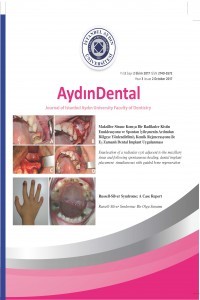CHAIRSIDE CEREC SYSTEM AND CAD/CAM MATERIALS
materyalleri, cam seramik, CEREC, hasta başında, metal desteksiz, optik ölçü, rezin nanoseramik
CHAIRSIDE CEREC SYSTEM AND CAD/CAM MATERIALS
CAD/CAM CAD/CAM Materials, CEREC, chairside, glass-ceramic, metal-free, optical impression, resin nanoceramic,
___
- Otto T, Schneider D. Long-term clinical results of chairside Cerec CAD/CAM inlays and onlays: a case series. Int J Prosthodont. 2008; 21(1):53-9.
- Liu PR. A panorama of dental CAD/CAM restorative systems. Compend Contin Educ Dent. 2005; 26(7):507-27.
- Mörmann WH, Brandestini M, Lutz F, Barbakow F. Chairside computer-aided direct ceramic inlays. Quintessence Int. 1989; 20(5):329-39.
- Mörmann WH. The origin of the Cerec method: a personal review of the first 5 years. Int J Comput Dent. 2004; 7(1):11-24.
- Mörmann WH. The evolution of the CEREC system. J Am Dent Assoc. 2006; 137 Suppl: 7-13.
- Mörmann W, Krejci I. Computer-designed inlays after 5 years in situ: clinical performance and scanning electron microscopic evaluation. Quintessence Int. 1992; 23(2):109-15.
- Mörmann W, Brandestini M, Ferru A, Lutz F, Krejci I. Marginal adaptation of adhesive porcelain inlays in vitro. Schweiz Monatsschr Zahnmed, 1985; 95(12):1118-29.
- Lauvahutanon S, Takahashi H, Shiozawa M, Iwasaki N, Asakawa Y, Oki M, Finger WJ, Arksornnukit M. Mechanical properties of composite resin blocks for CAD/CAM. Dent Mater J. 2014; 33(5):705-10.
- Bindl A, Lüthy H, Mörmann WH. Fracture load of CAD/CAM-generated slot-inlay FPDs. Int J Prosthodont. 2003; 16(6):653-60.
- Fradeani M, Redemagni M, Corrado M. Porcelain laminate veneers: 6- to 12- year clinical evaluation--a retrospective study. Int J Periodontics Restorative Dent. 2005; 25(1):9- 17.
- Fasbinder DJ. Clinical performance of chairside CAD/CAM restorations. J Am Dent Assoc. 2006; 137 Suppl: 22S-31S.
- Martin N, Jedynakiewicz NM. Clinical performance of CEREC ceramic inlays: a systematic review. Dent Mater. 1999; 15(1):54- 61.
- Beier US, Kapferer I, Burtscher D, Giesinger JM, Dumfahrt H. Clinical performance of all- ceramic inlay and onlay restorations in posterior teeth. Int J Prosthodont. 2012; 25(4):395-402.
- Li RW, Chow TW, Matinlinna JP. Ceramic dental biomaterials and CAD/CAM technology: state of the art. J Prosthodont Res. 2014; 58(4):208-16.
- Giordano R, McLaren EA. Ceramics overview: classification by microstructure and processing methods. Compend Contin Educ Dent. 2010; 31(9):682-700.
- VITABLOCS® Working Instructions. Spitalgasse 3 D-79713 Bad Säckingen Germany. Retrieved February 09, 2016, from http://vitanorthamerica.com/wp-content/ uploads/2012/06/VITABLOCS-Working- Instructions_1769E.pdf
- New for CEREC: CEREC Blocs and CEREC Blocs PC in VITA Classical colors. Sirona - The Dental Company. Salzburg. Retrieved February 09, 2016, from http://www.sirona.com/en/ news-events/news-press/corporate-news- detail/32754.
- Vichi A,Sedda M, Del Siena F, Louca C, Ferrari M. Flexural resistance of Cerec CAD/ CAM system ceramic blocks. Part 1: Chairside materials. Am J Dent. 2013; 26(5):255-59.
- IPS e.max CAD Scientific Documentation IPS e.max. Lichtenstein. Retrieved February 02, 2016, from http://www.ivoclarvivadent.us/ emaxchangeseverything/ system/index.php.
- Albero A, Pascual A ,Camps I, María Grau- Benitez. Comparative characterization of a novel cad-cam polymer-infiltrated-ceramic- network. J Clin Exp Dent. 2015; 7(4):495-500.
- Sannino G, Germano F, Arcuri L, Bigelli E, Arcuri C, Barlattani A. CEREC CAD/CAM Chairside System. Oral Implantol (Rome). 2015; 7(3):57-70.
- Awada A, Nathanson D. Mechanical properties of resin-ceramic CAD/CAM restorative materials. J Prosthet Dent. 2015; 114(4):587-93.
- Coldea A, Swain MV, Thiel N. Mechanical properties of polymer-infiltrated-ceramic- network materials. Dent Mater. 2013; 29(4):419- 26.
- Coldea A, Swain MV, Thiel N. In-vitro strength degradation of dental ceramics and novel PICN material by sharp indentation. J Mech Behav Biomed Mater. 2013; 26:34-42.
- He LH, Swain M. A novel polymer infiltrated ceramic dental material. Dent Mater. 2011; 27(6):527-34.
- He L, Purton D, Swain M. A novel polymer infiltrated ceramic for dental simulation. J Mater Sci Mater Med. 2011;22: 1639-43.
- Bottino MA, Campos F, Ramos NC, Rippe MP, Valandro LF, Melo RM. Inlays made from a hybrid material: adaptation and bond strengths. Oper Dent. 2015; 40(3):83-91.
- Stawarczyk B, Liebermann A, Eichberger M, Güth JF. Evaluation of mechanical and optical behavior of current esthetic dental restorative CAD/CAM composites. J Mech Behav Biomed Mater. 2015; 55:1-11.
- El-Damanhoury HM, Haj-Ali RN, Platt JA. Fracture resistance and microleakage of endocrowns utilizing three CAD-CAM blocks. Oper Dent 2015; 40 (2):201-10.
- Koizumi H, Saiki O, Nogawa H, Hiraba H, Okazaki T, Matsumura H. Surface roughness and gloss of current CAD/CAM resin composites before and after toothbrush abrasion. Dent Mater J. 2015; 34(6):881-7.
- ISSN: 2149-5572
- Yayın Aralığı: Yılda 3 Sayı
- Başlangıç: 2015
- Yayıncı: İstanbul Aydın Üniversitesi
NANOCERAMICS AND HYBRID MATERIALS USED IN CAD/CAM SYSTEMS
Nesrin CEREN, Volkan TURP, Faruk EMİR, Gökhan AKGÜNGÖR, Simel AYYILDIZ, Deniz ŞEN
PULL-OUT STRENGTH OF FIBER POSTS LUTED WITH DIFFERENT SELF-ADHESIVES
Engin Fırat ÇAKAN, Fatma YILDIRIM, Ahu TOPKARA
ENDODONTIC TREATMENT OF MANDIBULAR PREMOLAR WITH THREE CANALS USING CBCT
Seda AYDEMİR, Alper SİNANOĞLU, İşıl Kaya BÜYÜKBAYRAM, Göze ARUKASLAN
SINGLE NO-PREP PORCELAIN LAMINATE VENEER RESTORATIONS; 2 CASE REPORTS
Volkan TURP, Simel AYYILDIZ, Deniz ŞEN, Gülcan BAHARDIRLI
PROLIFERATIVE VERRUCOUS LEUKOPLAKIA: FIVE YEARS FOLLOW-UP
Behçet EROL, Sercan KÜÇÜKKURT, Tuğçe Biçer AYTUGAR, Nihan AKSAKALLI
MUTAGENIC POTENTIAL OF A SELF-ADHESIVE FLOWABLE COMPOSITE
Tuğba TOZ, Zeliha AYDOĞAN, Duygu TUNCER, Emel KARAMAN
